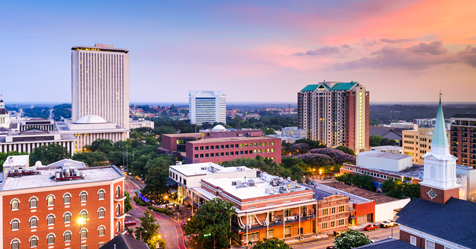Florida has long been home to a large number of immigrants, many of whom hail from the Caribbean. One in five residents in the state was born in another country. Together, immigrants make up more than a quarter of Florida’s labor force. As neighbors, business owners, taxpayers, and workers, immigrants are an integral part of Florida’s diverse and thriving communities and make extensive contributions that benefit all.
More than one in five Florida residents is an immigrant, while one in eight residents are native-born U.S. citizens with at least one immigrant parent.
- In 2018, 4.5 million immigrants (foreign-born individuals) comprised 21 percent of the population.
- Florida was home to 2.2 million women, 2 million men, and 247,316 children who were immigrants.
- The top countries of origin for immigrants were Cuba (23 percent of immigrants), Haiti (8 percent), Colombia (6 percent), Mexico (6 percent), and Jamaica (5 percent).
- In 2018, 2.7 million people in Florida (13 percent of the state’s population) were native-born Americans who had at least one immigrant parent.
More than half of all immigrants in Florida are naturalized U.S. citizens.
- 2.5 million immigrants (57 percent) had naturalized as of 2018, and 759,614 million immigrants were eligible to become naturalized U.S. citizens in 2017.
- Nearly three-quarters (74 percent) of immigrants reported speaking English “well” or “very well.”
Immigrants in Florida are distributed across the educational spectrum.
- More one-quarter (29 percent) of adult immigrants had a college degree or more education in 2018, while one-fifth (20 percent) had less than a high school diploma.
|
Education Level |
Share (%) of All Immigrants |
Share (%) of All Natives |
|---|---|---|
|
College degree or more |
29 |
31 |
|
Some college |
23 |
32 |
|
High school diploma only |
28 |
29 |
|
Less than a high school diploma |
20 |
9 |
|
Source: U.S. Census Bureau, 2018 American Community Survey 1-Year Estimates. |
||
More than 425,000 U.S. citizens in Florida live with at least one family member who is undocumented.
- 775,000 undocumented immigrants comprised 18 percent of the immigrant population and 4 percent of the total state population in 2016.
- 909,104 people in Florida, including 425,814 U.S. citizens, lived with at least one undocumented family member between 2010 and 2014.
- During the same period, about 7 percent of children in the state were U.S. citizens living with at least one undocumented family member (280,133 children in total).
Florida is home to more than 24,000 Deferred Action for Childhood Arrivals (DACA) recipients.
- 24,810 active DACA recipients lived in Florida as of March 2020, while DACA has been granted to 32,646 people in total since 2012.11F
- As of 2019, 33 percent of DACA-eligible immigrants in Florida had applied for DACA.12F
- An additional 18,000 residents of the state would satisfy all but the educational requirements for DACA, and fewer than 2,000 would become eligible as they grew older.13F
One in four workers in Florida is an immigrant, together making up a vital part of the state’s labor force in a range of industries.
- 2.7 million immigrant workers comprised 26 percent of the labor force in 2018.
- Immigrant workers were most numerous in the following industries:
|
Industry |
Number of Immigrant Workers |
|---|---|
|
Health Care and Social Assistance |
417,067 |
|
Retail Trade |
347,298 |
|
Construction |
305,888 |
|
Accommodation and Food Services |
290,074 |
|
Administrative & Support; Waste Management; and Remediation Services |
221,268 |
|
Source: Analysis of the U.S. Census Bureau’s 2018 American Community Survey 1-year PUMS data by the American Immigration Council. |
|
- The largest shares of immigrant workers were in the following industries:
|
Industry |
Immigrant Share (%) |
|---|---|
|
Agriculture, Forestry, Fishing, and Hunting |
41 |
|
Construction |
34 |
|
Transportation and Warehousing |
31 |
|
Administrative & Support; Waste Management; and Remediation Services |
30 |
|
Other Services (except Public Administration) |
30 |
|
Source: Analysis of the U.S. Census Bureau’s 2018 American Community Survey 1-year PUMS data by the American Immigration Council. |
|
Immigrants are an integral part of the Florida workforce in a range of occupations.
- In 2018, immigrant workers were most numerous in the following occupation groups:
|
Occupation Category |
Number of Immigrant Workers |
|---|---|
|
Sales and Related |
330,850 |
|
Office and Administrative Support |
294,741 |
|
Management |
269,513 |
|
Building and Grounds Cleaning & Maintenance |
261,770 |
|
Construction and Extraction |
251,958 |
|
Source: Analysis of the U.S. Census Bureau’s 2018 American Community Survey 1-year PUMS data by the American Immigration Council. |
|
- The largest shares of immigrant workers were in the following occupation groups:
|
Occupation Category |
Immigrant Share (%) |
|---|---|
|
Farming, Fishing, and Forestry |
49 |
|
Building and Grounds Cleaning & Maintenance |
44 |
|
Construction and Extraction |
38 |
|
Healthcare Support |
35 |
|
Production |
30 |
|
Source: Analysis of the U.S. Census Bureau’s 2018 American Community Survey 1-year PUMS data by the American Immigration Council. |
|
- Undocumented immigrants comprised 6 percent of Florida’s workforce in 2016.
Immigrants in Florida have contributed tens of billions of dollars in taxes.
- Immigrant-led households in the state paid $23.2 billion in federal taxes and $8.5 billion in state and local taxes in 2018.
- Undocumented immigrants in Florida paid an estimated $1.3 billion in federal taxes and $588.3 million in state and local taxes in 2018.
- Florida DACA recipients and DACA-eligible individuals paid an estimated $77.6 million in state and local taxes in 2018.
As consumers, immigrants add nearly one-hundred billion dollars to Florida’s economy.
- Florida residents in immigrant-led households had $98.5 billion in spending power (after-tax income) in 2018.
Immigrant entrepreneurs in Florida generate billions of dollars in business revenue.
- 437,690 immigrant business owners accounted for 33 percent of all self-employed Florida residents in 2018 and generated $7.1 billion in business income.
- In the following Florida metropolitan areas in 2018, at least one in five business owners was an immigrant. Immigrants accounted for:
- 57 percent of business owners in the Miami-Fort Lauderdale-Miami Beach metro area,
- 36 percent in Orlando,
- 29 percent in Tampa-St. Petersburg-Clearwater,
- 20 percent in Jacksonville.




